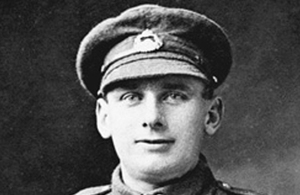WW1 Canadian VC recipient Arthur George Knight
The story of Canadian First World War Victoria Cross recipient Arthur George Knight.

Arthur George Knight [Credit: National Defence Canada]
70 men from Canada received the Victoria Cross, Britain’s highest award for gallantry, during the First World War. As part of the Centenary Commemorations the people of the United Kingdom marked their gratitude to those courageous men by presenting a bronze memorial plaque to their home country engraved with their names. The plaque is now displayed at the British High Commission Ottawa. This archive tells their stories.
Name: Arthur George Knight
DOB: 26 June 1886
Place of Birth: Haywards Heath, England
Date of Action: 2 September 1918
Place of Action: Cagnicourt, France
Rank: Sergeant
Regiment: 10th Infantry Battalion, Canadian Expeditionary Force
Arthur George Knight was born in Haywards Heath in England on 26 June 1886, and emigrated to Canada in 1911, where he worked as a carpenter. He enlisted in the Canadian Expeditionary Force in December 1914, joining the 10th Infantry Battalion. In November 1917 he received the Croix de Guerre from the Belgian Government.
Sergeant Knight was posthumously awarded the Victoria Cross for his bravery on 2 September 1918 in Cagnicourt, France. His citation states:
For most conspicuous bravery, initiative, and devotion to duty when, after an unsuccessful attack, Sjt. Knight led a bombing section forward, under very heavy fire of all descriptions, and engaged the enemy at close quarters. Seeing that his party continued to be held up, he dashed forward alone, bayoneting several of the enemy machine-gunners and trench mortar crews, and forcing the remainder to retire in confusion. He then brought forward a Lewis gun and directed his fire on the retreating enemy, inflicting many casualties. In the subsequent advance of his platoon in pursuit, Sjt. Knight saw a party of about thirty of the enemy go into a deep tunnel which led off the trench. He again dashed forward alone, and, having killed one officer and two N.C.O.s, captured twenty other ranks. Subsequently he routed, single-handed, another enemy party which was opposing the advance of his platoon. On each occasion he displayed the greatest valour under fire at very close range, and by his example of courage, gallantry, and initiative was a wonderful inspiration to all. This very gallant N.C.O. was subsequently fatally wounded.
Sergeant Knight died of his wounds the following day and was buried at the Dominion Cemetery in France. Two Streets have been named in his honour, and a memorial plaque has been placed where he lived in Regina, Sasketchewan.